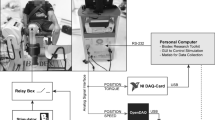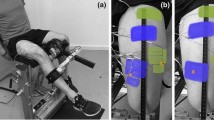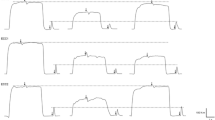Abstract
Purpose
The present study was designed to determine the stimulation intensity necessary for an adequate assessment of central and peripheral components of neuromuscular fatigue of the knee extensors.
Methods
Three different stimulation intensities (100, 120 and 150 % of the lowest intensity evoking a plateau in M-waves and twitch amplitudes, optimal stimulation intensity, OSI) were used to assess voluntary activation level (VAL) as well as M-wave, twitch and doublet amplitudes before, during and after an incremental isometric exercise performed by 14 (8 men) healthy and physically active volunteers. A visual analog scale was used to evaluate the associated discomfort.
Results
There was no difference (p > 0.05) in VAL between the three intensities before and after exercise. However, we found that stimulating at 100 % OSI may overestimate the extent of peripheral fatigue during exercise, whereas 150 % OSI stimulations led to greater discomfort associated with doublet stimulations as well as to an increased antagonist co-activation compared to 100 % OSI.
Conclusion
We recommend using 120 % OSI, as it constitutes a good trade-off between discomfort and reliable measurements.



Similar content being viewed by others
Abbreviations
- BF:
-
Biceps femoris
- EMG:
-
Electromyography
- MVC:
-
Maximal Voluntary Contraction
- OSI:
-
Optimal Stimulation Intensity
- RF:
-
Rectus femoris
- RMS:
-
Root Mean Square
- RMS/M:
-
RMS normalized by the M-wave amplitude
- VAL:
-
Voluntary Activation Level
- VL:
-
Vastus lateralis
- VM:
-
Vastus medialis
References
Adam A, De Luca CJ (2005) Firing rates of motor units in human vastus lateralis muscle during fatiguing isometric contractions. J Appl Physiol 99(1):268–280
Allen GM, Gandevia SC, McKenzie DK (1995) Reliability of measurements of muscle strength and voluntary activation using twitch interpolation. Muscle Nerve 18(6):593–600
Alon G (1985) High voltage stimulation. Effects of electrode size on basic excitatory responses. Phys Ther 65(6):890–895
Amann M (2011) Central and peripheral fatigue: interaction during cycling exercise in humans. Med Sci Sports Exerc 43(11):2039–2045
Babault N, Pousson M, Ballay Y, Van Hoecke J (2001) Activation of human quadriceps femoris during isometric, concentric, and eccentric contractions. J Appl Physiol 91(6):2628–2634
Bachasson D, Millet GY, Decorte N, Wuyam B, Levy P, Verges S (2013) Quadriceps function assessment using an incremental test and magnetic neurostimulation: a reliability study. J Electromyogr Kinesiol 23(3):649–658
Bampouras TM, Reeves ND, Baltzopoulos V, Jones DA, Maganaris CN (2012) Is maximum stimulation intensity required in the assessment of muscle activation capacity? J Electromyogr Kinesiol 22(6):873–877
Behm DG, St-Pierre DM, Perez D (1996) Muscle inactivation: assessment of interpolated twitch technique. J Appl Physiol 81:2267–2273
Bigland-Ritchie B, Furbush F, Woods JJ (1986) Fatigue of intermittent submaximal voluntary contractions: central and peripheral factors. J Appl Physiol 61(2):421–429
Burke D (2002) Effects of activity on axonal excitability: implications for motor control studies. Adv Exp Med Biol 508:33–37
Butler JE, Taylor JL, Gandevia SC (2003) Responses of human motoneurons to corticospinal stimulation during maximal voluntary contractions and ischemia. J Neurosci 23(32):10224–10230
Button DC, Behm DG (2008) The effect of stimulus anticipation on the interpolated twitch technique. J Sports Sci Med 7:520–524
Edwards RH, Hill DK, Jones DA, Merton PA (1977) Fatigue of long duration in human skeletal muscle after exercise. J Physiol 272(3):769–778
Elias LJ, Bryden MP, Bulman-Fleming MB (1998) Footedness is a better predictor than is handedness of emotional lateralization. Neuropsychologia 36(1):37–43
Folland JP, Williams AG (2007) Methodological issues with the interpolated twitch technique. J Electromyogr Kinesiol 17(3):317–327
Froyd C, Millet GY, Noakes TD (2013) The development of peripheral fatigue and short-term recovery during self-paced high-intensity exercise. J Physiol 591:1339–1346
Gandevia SC (2001) Spinal and supraspinal factors in human muscle fatigue. Physiol Rev 81(4):1725–1789
Gondin J, Guette M, Jubeau M, Ballay Y, Martin A (2006) Central and peripheral contributions to fatigue after electrostimulation training. Med Sci Sports Exerc 38(6):1147–1156
Hamada T, Sale DG, MacDougall JD, Tarnopolsky MA (2000) Postactivation potentiation, fiber type, and twitch contraction time in human knee extensor muscles. J Appl Physiol 88(6):2131–2137
Hermens HJ, Freriks B, Disselhorst-Klug C, Rau G (2000) Development of recommendations for SEMG sensors and sensor placement procedures. J Electromyogr Kinesiol 10(5):361–374
Hicks A, Fenton J, Garner S, McComas AJ (1989) M wave potentiation during and after muscle activity. J Appl Physiol 66(6):2606–2610
Kernell D, Monster AW (1982a) Time course and properties of late adaptation in spinal motoneurones of the cat. Exp Brain Res 46(2):191–196
Kernell D, Monster AW (1982b) Motoneurone properties and motor fatigue. An intracellular study of gastrocnemius motoneurones of the cat. Exp Brain Res 46(2):197–204
Klass M, Roelands B, Levenez M, Fontenelle V, Pattyn N, Meeusen R, Duchateau J (2012) Effects of noradrenaline and dopamine on supraspinal fatigue in well-trained men. Med Sci Sports Exerc 44(12):2299–2308
Kooistra RD, de Ruiter CJ, de Haan A (2007) Conventionally assessed voluntary activation does not represent relative voluntary torque production. Eur J Appl Physiol 100(3):309–320
Kubo K, Tsunoda N, Kanehisa H, Fukunaga T (2004) Activation of agonist and antagonist muscles at different joint angles during maximal isometric efforts. Eur J Appl Physiol 91(2–3):349–352
Kufel TJ, Pineda LA, Mador MJ (2002) Comparison of potentiated and unpotentiated twitches as an index of muscle fatigue. Muscle Nerve 25(3):438–444
Lagerquist O, Collins DF (2010) Influence of stimulus pulse width on M-waves, H-reflexes, and torque during tetanic low-intensity neuromuscular stimulation. Muscle Nerve 42(6):886–893
Lévénez M, Kotzamanidis C, Carpentier A, Duchateau J (2005) Spinal reflexes and coactivation of ankle muscles during a submaximal fatiguing contraction. J Appl Physiol 99:1182–1188
Löscher WN, Cresswell AG, Thorstensson A (1996) Central fatigue during a long-lasting submaximal contraction of the triceps surae. Exp Brain Res 108(2):305–314
Marcora SM, Staiano W (2010) The limit to exercise tolerance in humans: mind over muscle? Eur J Appl Physiol 109(4):763–770
Martin V, Millet GY, Martin A, Deley G, Lattier G (2004) Assessment of low-frequency fatigue with two methods of electrical stimulation. J Appl Physiol 97(5):1923–1929
Merton PA (1954) Voluntary strength and fatigue. J Physiol 123(3):553–564
Millet GY (2011) Can neuromuscular fatigue explain running strategies and performance in ultra-marathons?: the flush model. Sports Med 41(6):489–506
Millet GY, Lepers R (2004) Alterations of neuromuscular function after prolonged running, cycling and skiing exercises. Sports Med 34(2):105–116
Millet GY, Martin V, Martin A, Vergès S (2011a) Electrical stimulation for testing neuromuscular function: from sport to pathology. Eur J Appl Physiol 111(10):2489–2500
Millet GY, Tomazin K, Verges S, Vincent C, Bonnefoy R, Boisson RC, Gergele L, Feasson L, Martin V (2011b) Neuromuscular consequences of an extreme mountain ultra-marathon. PLoS ONE 6(2):1–14
Millet GY, Bachasson D, Temesi J, Wuyam B, Feasson L, Verges S, Levy P (2012) Potential interests and limits of magnetic and electrical stimulation techniques to assess neuromuscular fatigue. Neuromuscul Disord 22(Suppl 3):S181–S186
Neyroud D, Maffiuletti NA, Kayser B, Place N (2012) Mechanisms of Fatigue and Task Failure Induced By Sustained Submaximal Contractions. Med Sci Sports Exerc 44:1243–1251
Neyroud D, Ruttimann J, Mannion AF, Millet GY, Maffiuletti NA, Kayser B, Place N (2013) Comparison of neuromuscular adjustments associated with sustained isometric contractions of four different muscle groups. J Appl Physiol 114:1426–1434
Perrey S, Racinais S, Saimouaa K, Girard O (2010) Neural and muscular adjustments following repeated running sprints. Eur J Appl Physiol 109(6):1027–1036
Place N, Maffiuletti NA, Ballay Y, Lepers R (2005) Twitch potentiation is greater after a fatiguing submaximal isometric contraction performed at short vs. long quadriceps muscle length. J Appl Physiol 98(2):429–436
Place N, Maffiuletti NA, Martin A, Lepers R (2007) Assessment of the reliability of central and peripheral fatigue after sustained maximal voluntary contraction of the quadriceps muscle. Muscle Nerve 35:486–495
Place N, Casartelli N, Glatthorn JF, Maffiuletti NA (2010a) Comparison of quadriceps inactivation between nerve and muscle stimulation. Muscle Nerve 42(6):894–900
Place N, Yamada T, Bruton JD, Westerblad H (2010b) Muscle fatigue: from observations in humans to underlying mechanisms studied in intact single muscle fibres. Eur J Appl Physiol 110:1–15
Rassier DE, Macintosh BR (2000) Coexistence of potentiation and fatigue in skeletal muscle. Braz J Med Biol Res 33(5):499–508
Requena B, Gapeyeva H, Garcia I, Ereline J, Paasuke M (2008) Twitch potentiation after voluntary versus electrically induced isometric contractions in human knee extensor muscles. Eur J Appl Physiol 104(3):463–472
Rodriguez-Falces J, Maffiuletti NA, Place N (2013) Twitch and M-wave potentiation induced by intermittent maximal voluntary quadriceps contractions: Differences between direct quadriceps and femoral nerve stimulation. Muscle Nerve. doi:10.1002/mus.23856
Rupp T, Jubeau M, Wuyam B, Perrey S, Levy P, Millet GY, Verges S (2012) Time-dependent effect of acute hypoxia on corticospinal excitability in healthy humans. J Neurophysiol 108(5):1270–1277
Rutherford OM, Jones DA, Newham DJ (1986) Clinical and experimental application of the percutaneous twitch superimposition technique for the study of human muscle activation. J Neurol Neurosurg Psychiatry 49(11):1288–1291
Sale D, Quinlan J, Marsh E, McComas AJ, Belanger AY (1982) Influence of joint position on ankle plantarflexion in humans. J Appl Physiol 52(6):1636–1642
Sidhu SK, Bentley DJ, Carroll TJ (2009) Locomotor exercise induces long-lasting impairments in the capacity of the human motor cortex to voluntarily activate knee extensor muscles. J Appl Physiol 106(2):556–565
Sogaard K, Gandevia SC, Todd G, Petersen NT, Taylor JL (2006) The effect of sustained low-intensity contractions on supraspinal fatigue in human elbow flexor muscles. J Physiol 573:511–523
Staehli S, Glatthorn JF, Casartelli N, Maffiuletti NA (2010) Test-retest reliability of quadriceps muscle function outcomes in patients with knee osteoarthritis. J Electromyogr Kinesiol 20(6):1058–1065
Strojnik V, Komi PV (1998) Neuromuscular fatigue after maximal stretch-shortening cycle exercise. J Appl Physiol 84(1):344–350
Swart J, Lamberts RP, Lambert MI, Lambert EV, Woolrich RW, Johnston S, Noakes TD (2009) Exercising with reserve: exercise regulation by perceived exertion in relation to duration of exercise and knowledge of endpoint. Br J Sports Med 43(10):775–781
Temesi J, Arnal PJ, Davranche K, Bonnefoy R, Levy P, Verges S, Millet GY (2013) Does Central Fatigue Explain Reduced Cycling after Complete Sleep Deprivation? Med Sci Sports Exerc. doi:10.1249/MSS.0b013e31829ce379
Vagg R, Mogyoros I, Kiernan MC, Burke D (1998) Activity-dependent hyperpolarization of human motor axons produced by natural activity. J Physiol 507:919–925
Wüst RC, Morse CI, de Haan A, Rittweger J, Jones DA, Degens H (2008) Skeletal muscle properties and fatigue resistance in relation to smoking history. Eur J Appl Physiol 104(1):103–110
Zory R, Boerio D, Jubeau M, Maffiuletti NA (2005) Central and peripheral fatigue of the knee extensor muscles induced by electromyostimulation. Int J Sports Med 26(10):847–853
Acknowledgments
This study was supported by the De Reuter foundation and the Geneva Academic Society. The authors thank all the subjects who volunteered to participate and Marc Buclin for the design and conception of the ergometer.
Conflict of interest
The authors declare that they have no conflict of interest.
Author information
Authors and Affiliations
Corresponding author
Additional information
Communicated by Toshio Moritani.
Rights and permissions
About this article
Cite this article
Neyroud, D., Vallotton, A., Millet, G.Y. et al. The effect of muscle fatigue on stimulus intensity requirements for central and peripheral fatigue quantification. Eur J Appl Physiol 114, 205–215 (2014). https://doi.org/10.1007/s00421-013-2760-2
Received:
Accepted:
Published:
Issue Date:
DOI: https://doi.org/10.1007/s00421-013-2760-2




